Big Ideas Math Algebra 1 Student Journal 1st Edition Chapter 5 Solving Systems Of Linear Equations
Page 132 Essential Question Answer
A linear equation is an algebraic equation where each term has an exponent of one and we know that there are linear equations in one variable and linear equations in two variables.
To solve a system of linear equations.
A System of Linear Equations is when we have two or more linear equations working together. A system of linear equations is a set of two linear equations with two variables.
For example, x + 2y = 1,3x + 4y = 10 mare both linear equations with two variables but when they are considered together, they form a system of linear equations.
A system of linear equations can be solved by substitution, elimination, and graphing. The substitution method is since each equation in the system has two variables, so one way to reduce the number of variables in an equation is to substitute an expression for a variable.
The elimination method is since each equation in the system has two variables, so one way to reduce the number of variables is to add or subtract the two equations in the system to eliminate, one of the variables.
Graph the first equation and the second equation on the same rectangular coordinate system and determine whether the lines intersect, are parallel, or are the same line to identify the solution to the system.
Read and Learn More Big Ideas Math Algebra 1 Student Journal 1st Edition Solutions
A system of linear equations can be solved by the substitution method where an equation is substituted in an expression for a variable, the elimination method where two equations are added or subtracted to eliminate one of the variables, and the graphing method which is solved by graphing the first and the second equation on the same rectangular coordinate system and determining whether the lines intersect.
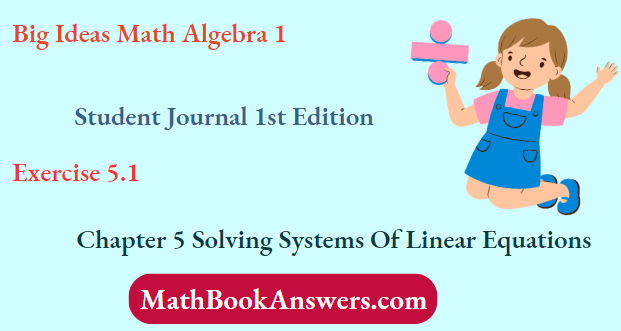
Big Ideas Math Algebra 1 Chapter 5 Exercise 5.1 Solutions
Big Ideas Math Algebra 1 Student Journal 1st Edition Chapter 5 Solving Systems Of Linear Equations Exercise 5.1 Page 132 Exercise 1 Answer
Given: That your family opens a bed-and-breakfast and they spend $600 preparing a bedroom to rent and the cost to your family for food and utilities is $15 per night. Your family charges $75 per night to rent the bedroom.
To write an equation that represents the costs.
The family spends $600 to prepare the bedroom and for every night the cost for food and utilities is $15.
Let the number of nights be x.
So, the equation can be written as the cost for food and utility times the number of nights plus the cost spent to prepare the bedroom.
The equation that represents the costs is C=15x+600
Your family opens a bed-and-breakfast and they spend $600 preparing a bedroom to rent and the cost to your family for food and utilities is $15 per night so if they charge $75 per night to rent the bedroom then, an equation that represents the costs is C=15x + 600
Given: That your family opens a bed-and-breakfast and they spend $600 preparing a bedroom to rent and the cost to your family for food and utilities is $15 per night. Your family charges $75 per night to rent the bedroom.
To write an equation that represents the revenue (income).
The family spends $600 to prepare the bedroom and for every night the cost for food and utilities is $15.
And they charge $75 per night to rent the bedroom. Let the number of nights be denoted by x.
So, the income is the charge of rent for the bedroom per night.
The equation that represents the revenue or income isR=75x
Your family opens a bed-and-breakfast and they spend $600 preparing a bedroom to rent and the cost to your family for food and utilities is $15 per night so if they charge $75 per night to rent the bedroom then, an equation that represents the revenue or income is R=75x
Given: That your family opens a bed-and-breakfast and they spend $600 preparing a bedroom to rent and the cost to your family for food and utilities is $15 per night. Your family charges $75 per night to rent the bedroom.
If a set of two (or more) linear equations is called a system of linear equations then to, write the system of linear equations for this problem.
The family spends $600 to prepare the bedroom and for every night the cost for food and utilities is $15.
And they charge $75 per night to rent the bedroom. Let the number of nights be denoted by x.
The equation that represents the costs is the cost for food and utility times the number of nights plus the cost spent to prepare the bedroom which is represented by C=15x + 600.
The equation that represents the revenue or income is the charge of rent for the bedroom per night which is represented by R = 75x
So, a system of linear equations for this problem is C=15x + 600 R = 75x
Your family opens a bed-and-breakfast and they spend $600
preparing a bedroom to rent and the cost to your family for food and utilities is $15 per night so if they charge $75 per night to rent the bedroom then, the system of linear equations for this problem is C=15x + 600 R =75x
Page 132 Exercise 2 Answer
We are given a situation where a family is starting a bed and breakfast business.

We are asked to fill a given table.
The values to be filled are the cost incurred by the family while starting the business.
The cost incurred is 600 $ on preparing the bedroom to rent and 15$ is charged on the breakfast.
Also, the revenue generated by the said business.
The revenue generated is the amount charged from the customers that is 75 $.
We have to look for a break-even point as well.
Given: Cost incurred
15x + 600
Revenue generated
75x
where x is the number of days
Table:
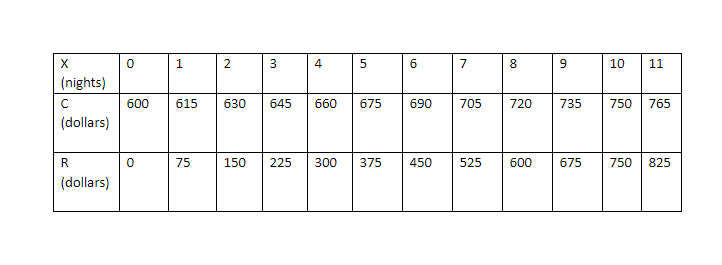
The cost and revenue equation used to determine the number of nights the family in tabular form:
Table:

We are given a situation where a family is starting a bed and breakfast business.
We are asked to find the number of nights it will take to get the amount spent on preparing the bedroom back.
The values are the cost incurred by the family while starting the business.
The cost incurred is 600 $ on preparing the bedroom to rent and 15 $ is charged on the breakfast.
Also, the revenue generated by the said business.
The revenue generated is the amount that is charged to the customers that is 75 $.
We have to look for a break-even point.
Given: Cost incurred (equation)
15x + 600
Revenue generated (equation)
75x
where x is the number of days
Table: (from the above table )

From the table, we observe that on the tenth day, the cost incurred is the same as the revenue generated.
This is the break-even point.
Hence, the number of nights needed to get the investment back is 10.
The number of nights the family will take to get the amount spent on preparing the bedroom is 10.
We are given a situation where a family is starting a bed and breakfast business.
We are asked to mark points in a graph on the values of cost and revenue generated.
The values are the cost incurred by the family while starting the business.
The cost incurred is 600 $ on preparing the bedroom to rent and 15
$ is charged on the breakfast.
Also, the revenue generated by the said business.
The revenue generated is the amount charged from the customers that is 75 $.
Given: Cost incurred (equation)
15x + 600
Revenue generated (equation)
75x
where x is the number of days
Graph:

The cost and revenue equation generated when the family started a bed and breakfast business in graphical form is
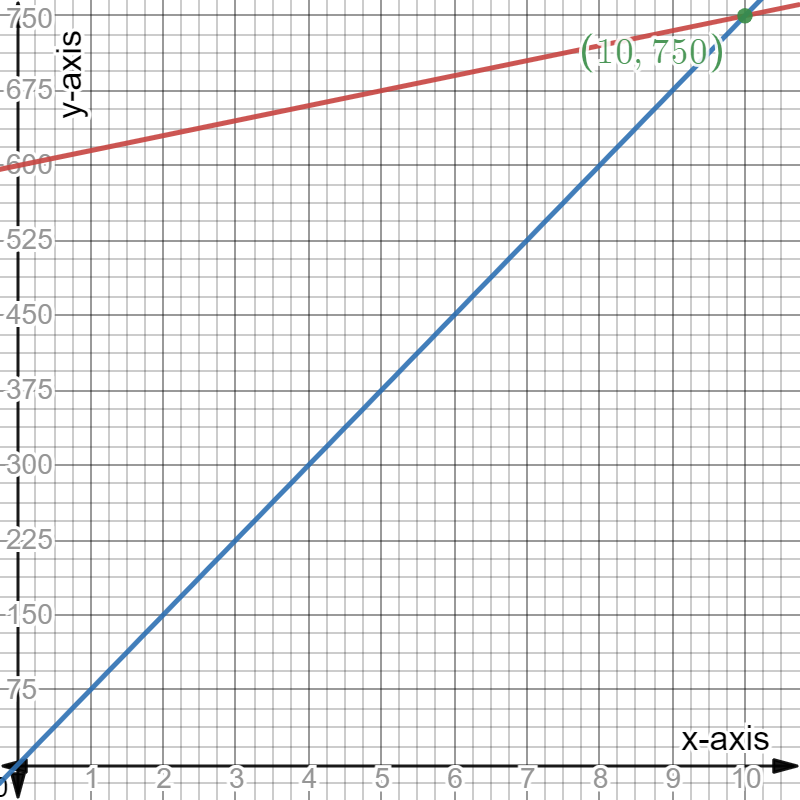
We are given a situation where a family is starting a bed and breakfast business.
We are asked to find the point of intersection, and describe it and compare it with break-even point.
The values are the cost incurred by the family while starting the business.
The cost incurred is 600 $ on preparing the bedroom to rent and 15 $ is charged on the breakfast.
Also, the revenue generated by the said business.
The revenue generated is the amount charged from the customers that is 75$.
We have to look for a break-even point.
Given: Cost incurred (equation)
15x + 600
Revenue generated (equation)
75x
where x is the number of days
Graph:
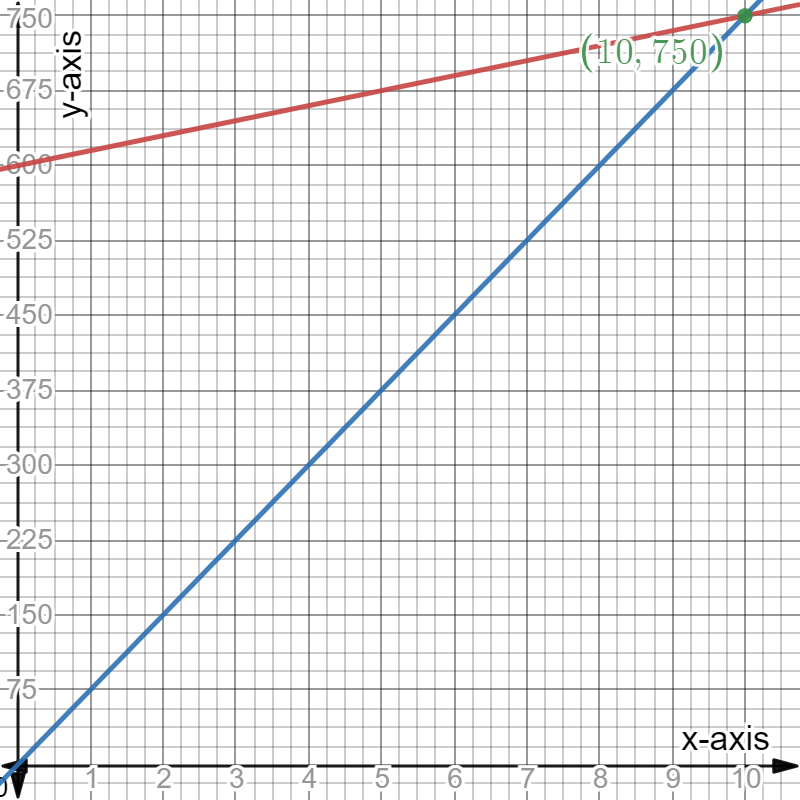
The point of intersection is (10,750).
This is the value where the cost and revenue become equal. After this point, there is profit.
Comparison:
The point of intersection is the same as the break-even point i.e. (10,750).
They correspond to the same value, that is the solution for the given set of equations.
It is inferred that after this point profit margin begins. This point is where the two values become equal.
The cost and revenue equation used to determine the number of nights the family will take to get the amount spent on preparing the bedroom when represented graphically meets at a point (10,750).

Solving Systems Of Equations Exercise 5.1 Answers
Big Ideas Math Algebra 1 Student Journal 1st Edition Chapter 5 Solving Systems Of Linear Equations Exercise 5.1 Page 133 Exercise 4 Answer
Given: We are given an equation y=−4.3x−1.3 y=1.7x+4.7.
We are asked to solve it by either using a table or a graph.
We are also asked to explain our reasons for choosing any of the methods.
We have to check our results using a graphing calculator.
For the given equation we are using a graph.
We have to plot both the equations in the graph.
Their point of intersection is our required solution.
We are using a graph because it will give a clear, pictorial representation with exact values.
Equations(given): y=−4.3x−1.3 , y=1.7x + 4.7
Graph:

Point of intersection: (−1,3). This is the required solution.
Test solution: (−1,3)
First equation :
y = −4.3x−1.3
3 = −4.3×(−1)−1.3
3 = 4.3−1.3
3 = 3
Second equation :
y = 1.7x+4.7
3 = 1.7×(−1)+4.7
3 = −1.7+4.7
3 = 3
The solution for the equation y =−4.3x−1.3
y = 1.7x + 4.7 can be obtained using a graph as it gives the exact values.
The solution is (−1,3)as also checked by graphing calculator.
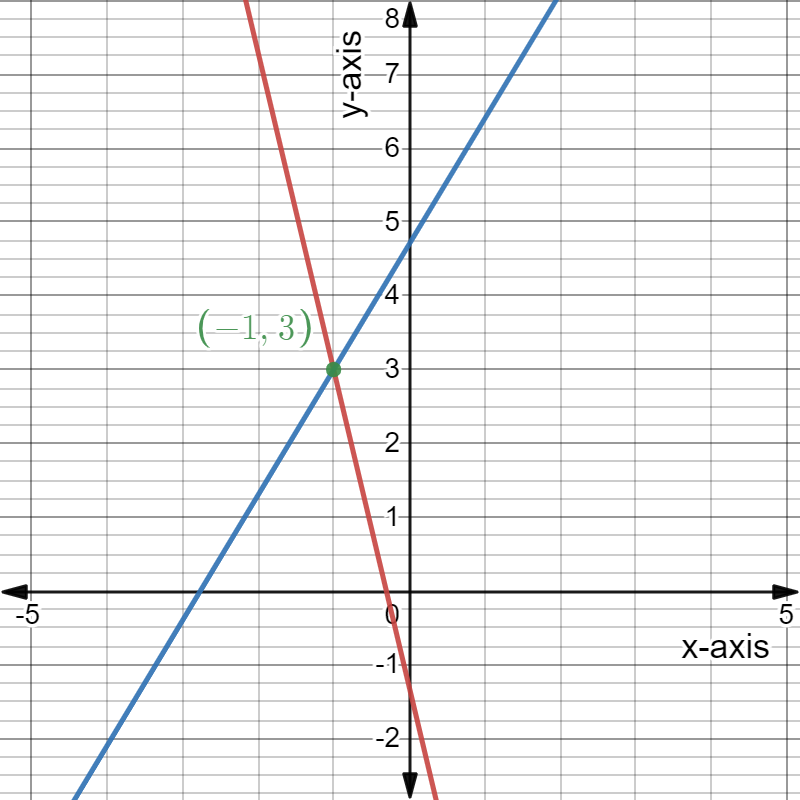
Given: We are given an equation y=x, y=−3x+8.
We are asked to solve it by either using a table or a graph.
We are also asked to explain our reasons for choosing any of the methods.
We have to check our results using a graphing calculator.
For the given equation we are using a graph.
We have to plot both the equations in the graph.
Their point of intersection is our required solution.
We are using a graph because will b give a clear, pictorial representation with exact values.
Equations(given): y = x ,y = −3x+8
Graph:
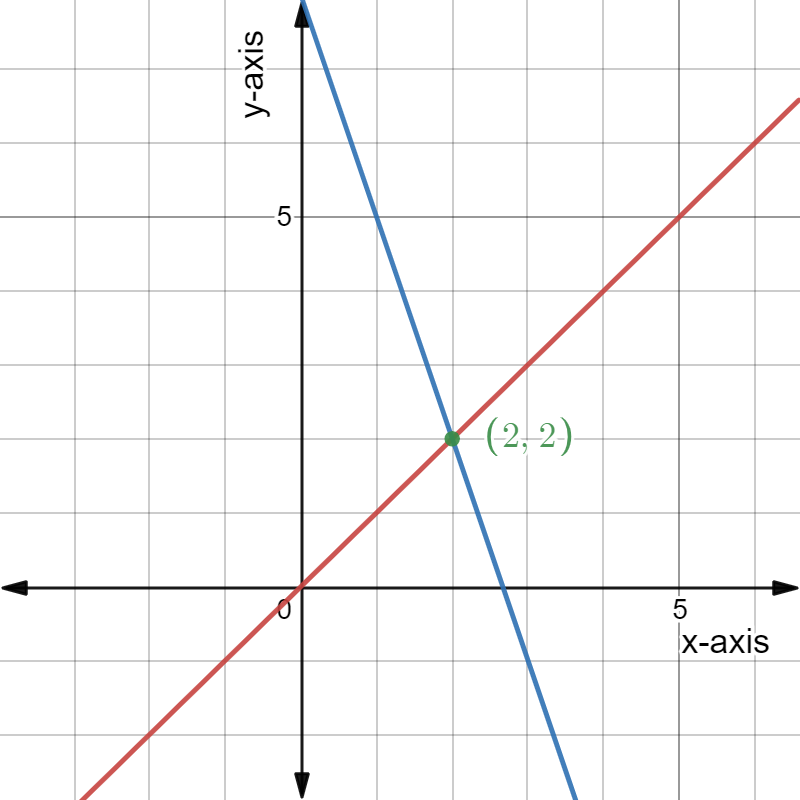
Point of intersection: (2,2). This is the required solution.
Test the solution: (2,2).
First equation :
y=x
2=2
Second equation :
y=−3x+8
2=−3×(2)+8
2=−6+8
2=2
The points are the correct solution.
The solution for the equation y = x, y =−3x + 8
Can be obtained using a graph as it gives the exact values.
The solution is (2,2) as also checked in graphing calculator.
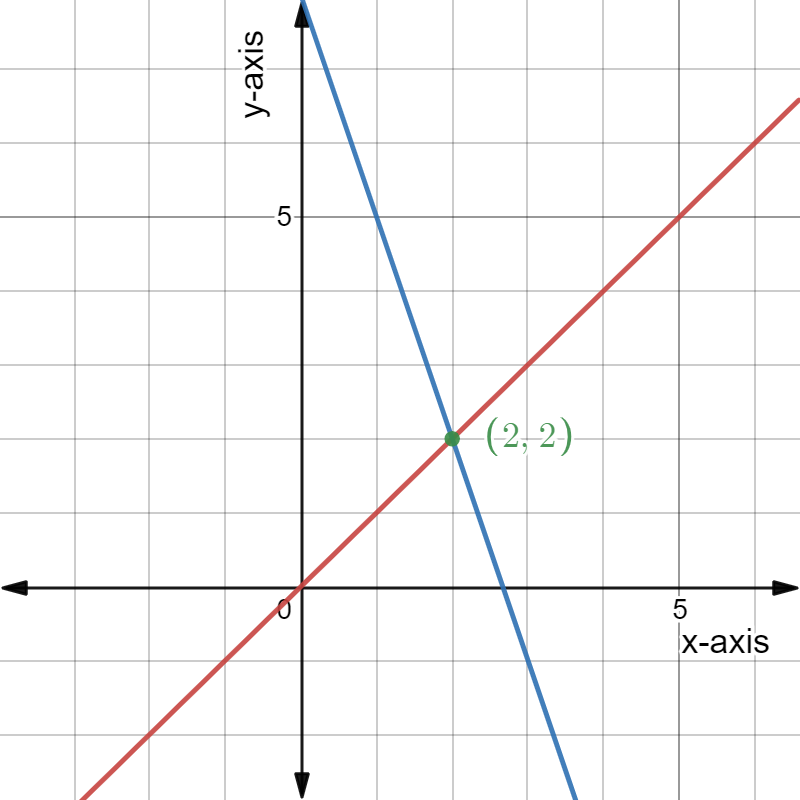
Given: We are given an equation y = −x−1, y = 3x+5.
We are asked to solve it by either using a table or a graph.
We are also asked to explain our reasons for choosing any of the methods.
We have to check our results using a graphing calculator.
For the given equation we are using a graph.
We have to plot both the equations in the graph.
Their point of intersection is our required solution.
We are using a graph because will b give a clear, pictorial representation with exact values.
Equations(given): y =−x−1 , y = 3x + 5
Graph:
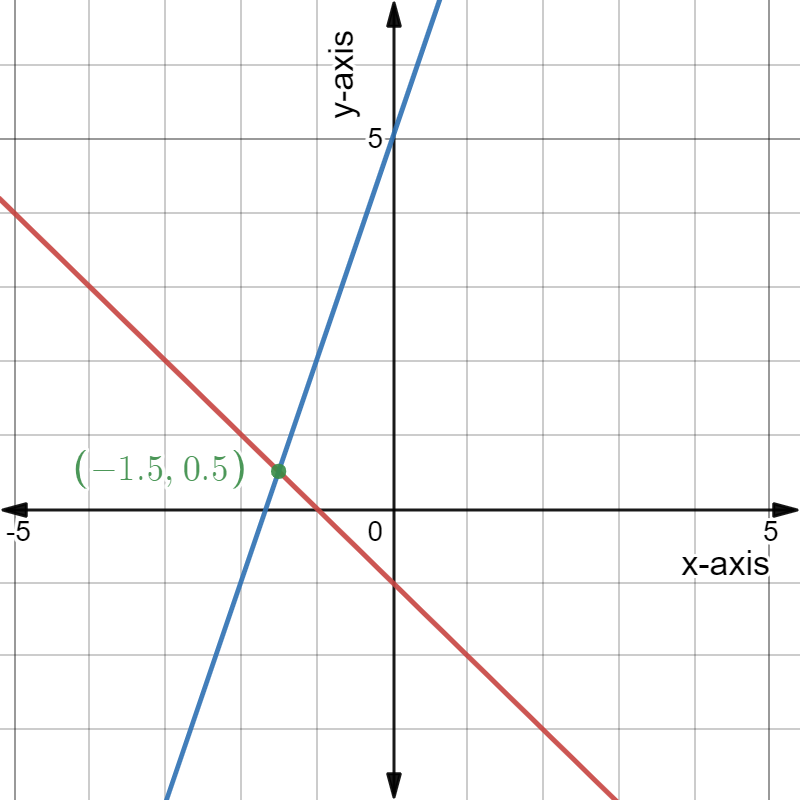
Point of intersection: (−1.5,0.5) The required set of values is the given solution.
Test solution: (−1.5,0.5)
First equation:
y = −x−1
0.5 =−(−1.5)−1
0.5 = + 1.5−1
0.5 = 0.5
Second equation:
y = 3x + 5
0.5 = 3×(−1.5)+5
0.5 = −4.5+5
0.5 = 0.5
The points are the correct solution.
The solution for the equation y = −x−1, y = 3x + 5
Can be obtained using a graph as it gives the exact values.
The solution is (−1.5,0.5)as also checked by graphing calculator.
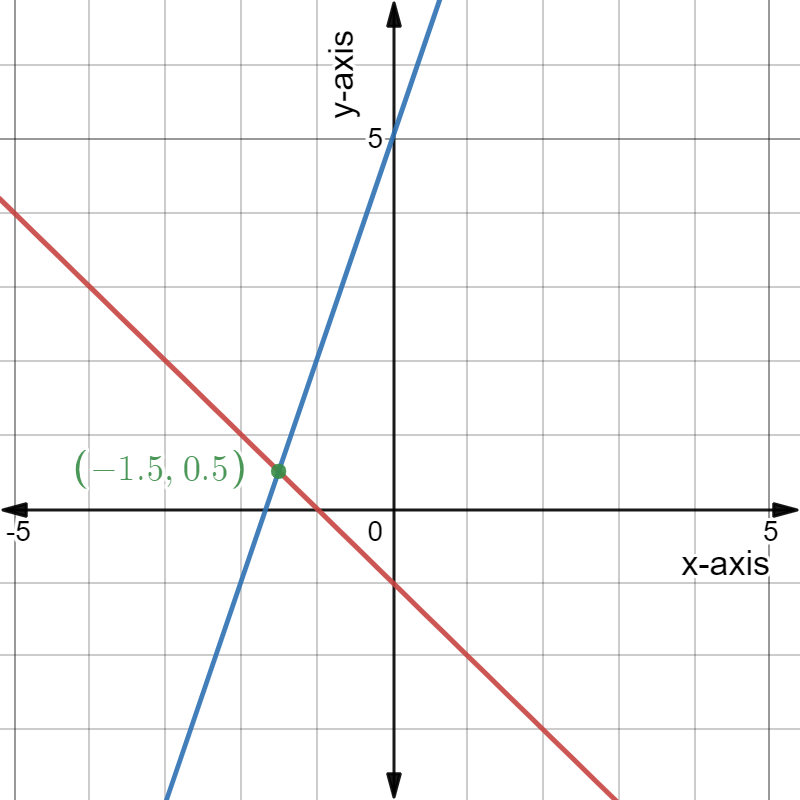
Big Ideas Math Algebra 1 Student Journal 1st Edition Chapter 5 Solving Systems Of Linear Equations Exercise 5.1 Page 135 Exercise 2 Answer
Given: We are given a set of linear equations x−y =−2, 2x + y = 5 along with an ordered pair (1,3).
We are asked to check whether the ordered pair is the solution for the system of linear equations.
In order to do so, we have to test the solution by putting the values of x and y in their respective positions in the linear equation.
We have to solve both equations with these values.
If the values are true, then the ordered pair is the solution for the given set.
Equations: x−y =−2, 2x + y = 5
Ordered pair: (1,3)
Test the solution:
Putting values of x and y as 1 and 3 respectively.
First Equation :
x−y =−2
1−3 =−2
−2 =−2
Second equation:
2x + y = 5
2×(1)+3 = 5
2 + 3 = 5
5=5
The given ordered pair is the solution for the system of linear equations.
The equations x−y = −2, 2x + y=5 on testing for a solution using the ordered pair (1,3) stand true.
Page 135 Exercise 3 Answer
Given: We are given a set of linear equations y = x−2, y =−3x + 6 along with an ordered pair (2,0).
We are asked to check whether the ordered pair is the solution for the system of linear equations.
In order to do so, we have to test the solution by putting the values of x and y in their respective positions in the linear equation.
We have to solve both equations with these values.
If the values are true, then the ordered pair is the solution for the given set.
Equations: y = x−2, y =−3x + 6
Ordered pair: (2,0)
Test the solution:
Putting values of x and y as 2 and 0 respectively.
First Equation :
y = x−2
0 = 2−2
0=0
Second equation:
y =−3x + 6
0 =−3×(2)+6
0 = −6+6
0 = 0
The given ordered pair is the solution for the system of linear equations.
The equations y =x−2, y =−3x + 6 on testing for a solution using the ordered pair (2,0) stand true.
Big Ideas Math Student Journal Exercise 5.1 Explained
Big Ideas Math Algebra 1 Student Journal 1st Edition Chapter 5 Solving Systems Of Linear Equations Exercise 5.1 Page 135 Exercise 4 Answer
Given: We are given a set of linear equations x−2y = 3, 2x−y = 0 along with an ordered pair (−1,−2).
We are asked to check whether the ordered pair is the solution for the system of linear equations.
In order to do so, we have to test the solution by putting the values of x and y in their respective positions in the linear equation.
We have to solve both equations with these values.
If the values are true, then the ordered pair is the solution for the given set.
Equations: x−2y = 3, 2x−y = 0
Ordered pair: (−1,−2)
Test the solution:
Putting values of x and y as −1 and −2 respectively.
First Equation :
x−2y = 3
−1−2×(−2) = 3
−1 + 4 = 3
3=3
Second equation:
2x−y = 0
2×(−1)−(−2) = 0
−2 + 2 = 0
0 = 0
The given ordered pair is the solution for the system of linear equations.
The equations x−2y = 3, 2x−y = 0 on testing for a solution using the ordered pair (−1,−2) stands True.
Page 135 Exercise 5 Answer
Given: We are given a set of linear equations 3x−2y =−12, 2x + 4y = 9 along with an ordered pair (−2,3).
We are asked to check whether the ordered pair is the solution for the system of linear equations.
In order to do so, we have to test the solution by putting the values of x and y in their respective positions in the linear equation.
We have to solve both equations with these values.
If the values are true, then the ordered pair is the solution for the given set.
Equations: 3x−2y =−12,2x + 4y = 9
Ordered pair: (−2,3)
Test the solution:
Putting values of x and y as −2 and 3 respectively.
First Equation :
3x−2y = −12
3×(−2)−2×(3) = −12
−6−6 =−12
−12 = −12
Second equation:
2x + 4y = 9
2×(−2)+4×(3) = 9
−4 + 12 = 9
8 = 9
The given ordered pair is not the solution for the system of linear equations.
The equations 3x−2y =−12, 2x + 4y = 9 o n testing for a solution using the ordered pair (−2,3) stand false.
Big Ideas Math Algebra 1 Student Journal 1st Edition Chapter 5 Solving Systems Of Linear Equations Exercise 5.1 Page 135 Exercise 7 Answer
Given: We are given a set of equations 3x−2y = 10, x + y = 0, and their graph.
We are asked to solve the equation using the graph.
In order to do so, we have to first find their point of intersection.
We need to get the coordinates of the point of intersection.
Using these values we have to solve the linear equation.
If these values satisfy, then the values are the solution for the set of linear equations.
Equations: 3x−2y = 10, x + y = 0
Graph:
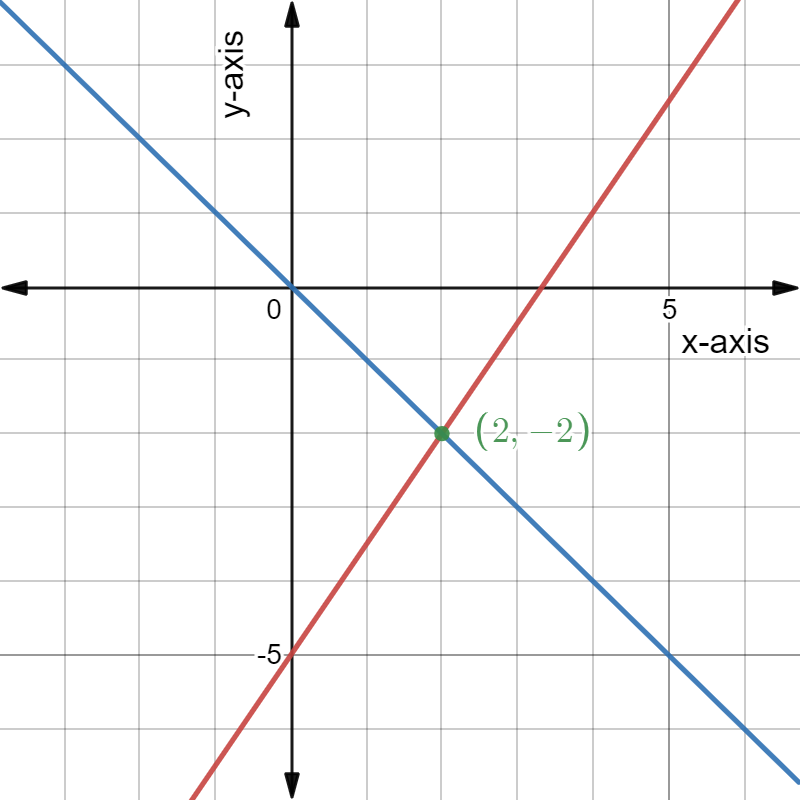
Point of intersection: (2,−2).
Test the solution: (2,−2):
Putting values of x and y as 2 and −2 respectively.
First Equation :
3x−2y = 10
3×(2)−2×(−2) = 10
6 + 4 = 10
10 = 10
Second equation:
x + y = 0
2 + (−2) = 0
2−2 =0
0 = 0
The given ordered pair is the solution for the system of linear equations.
The solution for the equations 3x−2y=10, x+y=0 using a graph is (2,−2).

Page 135 Exercise 8 Answer
Given: Graph of x−2y = 5, 2x + y = −5
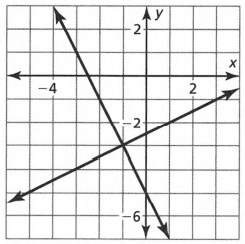
To Solve: The system of linear equations
Graph the first equation.
Graph the second equation on the same rectangular coordinate system.
Determine whether the lines intersect, are parallel, or are the same line.
Identify the solution to the system.
Graph of x−2y = 5, 2x + y =−5:
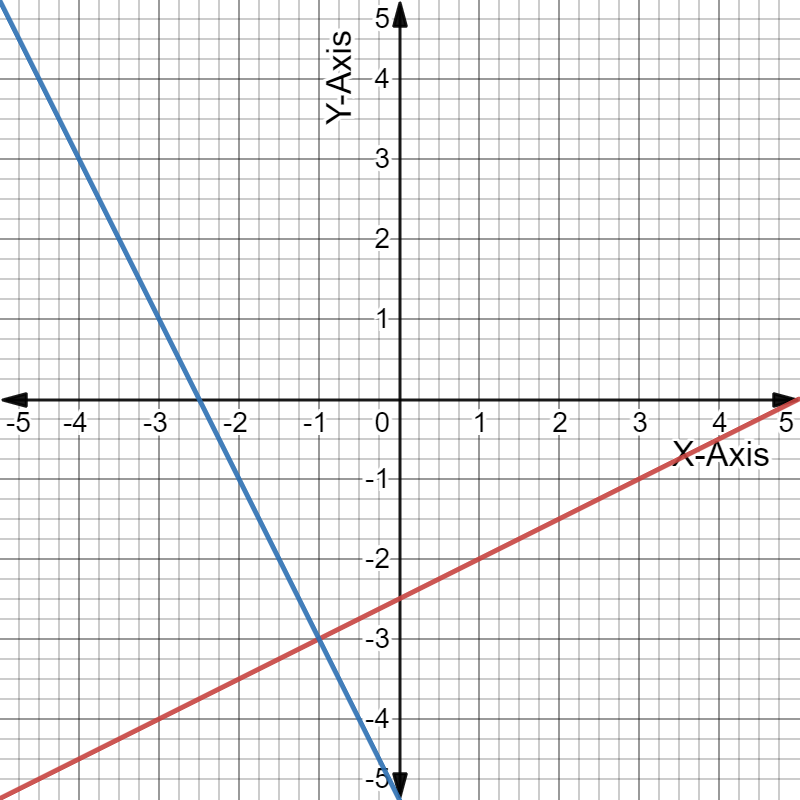
From the graph, it can be clearly seen that the point of intersection is (−1,−3).
We will put the value of x and y in the given equation to check whether our answer is correct.
x−2y=5 & 2x+y=−5
⇒ (−1)−2×(−3) = 5 & ⇒ 2(−1)+(−3) =−5
⇒−1 + 6 = 5 & ⇒ −2−3 =−5
⇒ 5 = 5 & ⇒ −5 =−5
The solution of the system of linear equations x−2y =5, 2x + y =−5 is (x,y)=(−1,−3).

Page 135 Exercise 9 Answer
Given: Graph of x + 2y = 8, 3x−2y = 8
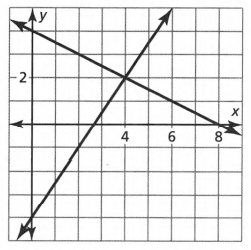
To Solve: The system of linear equations
Graph the first equation.
Graph the second equation on the same rectangular coordinate system.
Determine whether the lines intersect, are parallel, or are the same line.
Identify the solution to the system.
Graph of: x + 2y = 8, 3x−2y = 8

From the graph, it can be clearly seen that the point of intersection is (4,2).
We will put the value of x and y in the given equation to check whether our answer is correct.
x + 2y = 8 & 3x−2y = 8
⇒ 4 + 2×2 = 8 & ⇒ 3×4−2×2 = 8
⇒ 4 + 4 = 8 & ⇒ 12−4 = 8
⇒ 8 = 8 & ⇒ 8 = 8
The solution of the system of linear equations x+2y = 8, 3x−2y = 8 is (x,y) = (4,2).
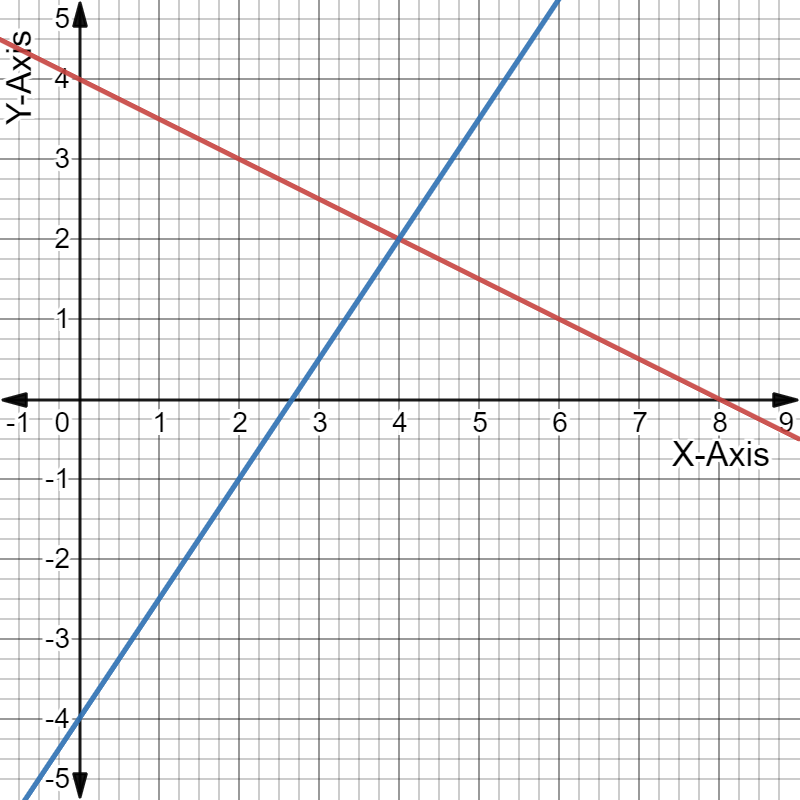
Chapter 5 Exercise 5.1 Solving Systems Practice
Page 136 Exercise 10 Answer
Given: y=−x + 3 , y=x + 5
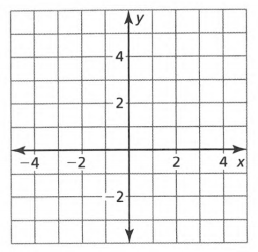
To Solve: The system of linear equations
Graph the first equation.
Graph the second equation on the same rectangular coordinate system.
Determine whether the lines intersect, are parallel, or are the same line.
Identify the solution to the system.
Graph of: y=−x + 3 : y=x + 5

From the graph, it can be clearly seen that the point of intersection is (−1,4).
The solution of the system of linear equations y =−x + 3, y = x+ 5 is (x,y) = (−1,4).

Page 136 Exercise 11 Answer
Given: y\(=\frac{1}{2} x+2\)
y\(=\frac{1}{2} x+4\)

To Solve: The system of linear equations
Graph the first equation.
Graph the second equation on the same rectangular coordinate system.
Determine whether the lines intersect, are parallel, or are the same line.
Identify the solution to the system.
Graph of :
y\(=\frac{1}{2} x+2\)
y\(=\frac{1}{2} x+4\)

From the graph, it can be clearly seen that the point of intersection is (2,3).
The solution of the system of linear equations
y\(=\frac{1}{2} x+2\)
y\(=\frac{1}{2} x+4\) is (x,y)=(2,3)
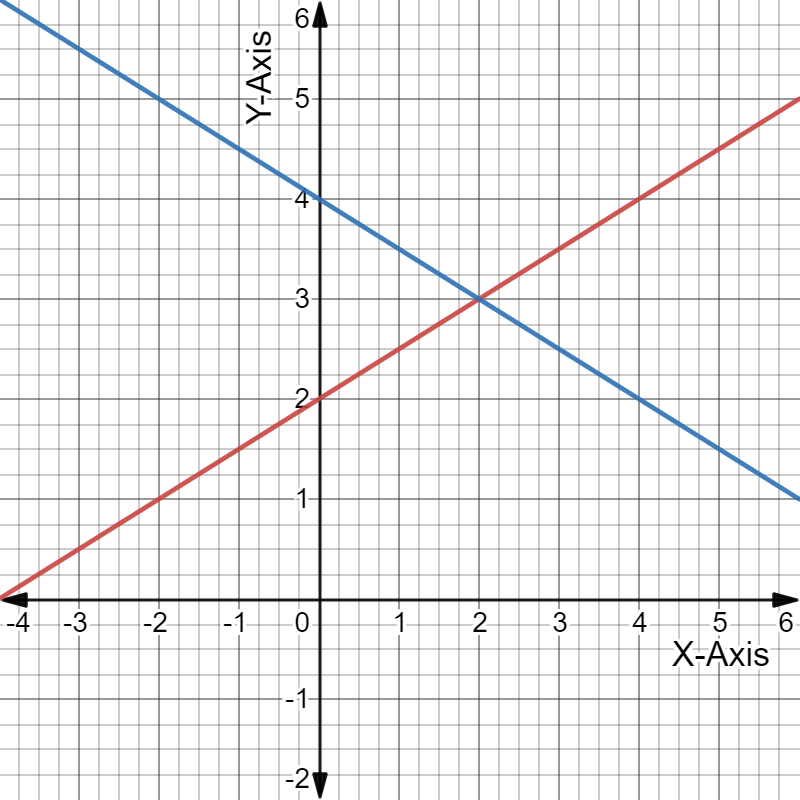
Page 136 Exercise 12 Answer
Given: 3x−2y = 6, y = −3
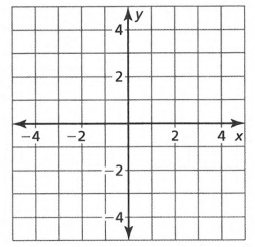
To Solve: The system of linear equations
Graph the first equation.
Graph the second equation on the same rectangular coordinate system.
Determine whether the lines intersect, are parallel, or are the same line. Identify the solution to the system.
Graph of : 3x−2y = 6 : y = −3
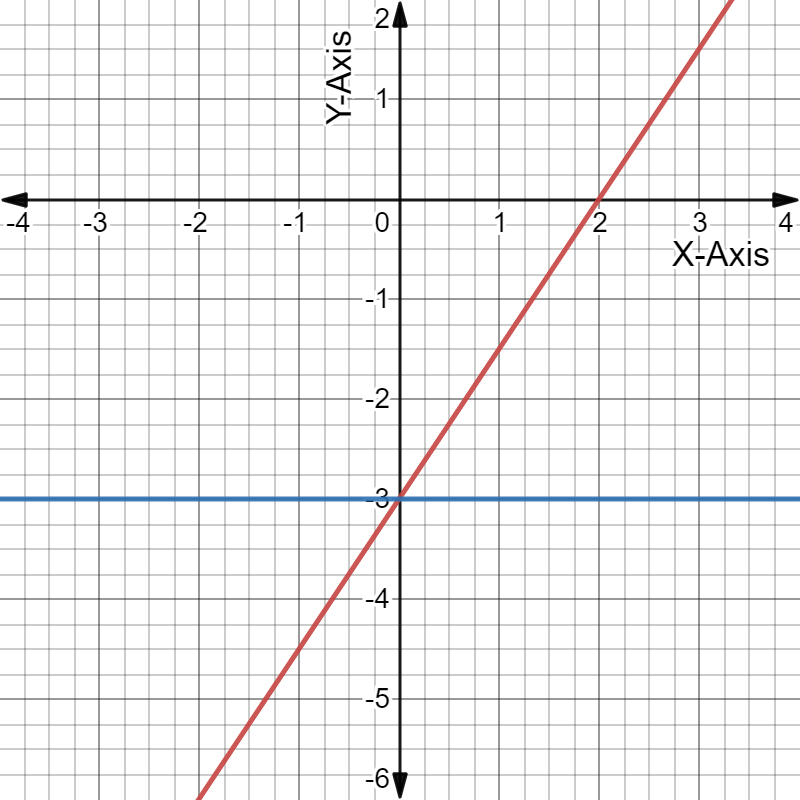
From the graph, it can be clearly seen that the point of intersection is (0,−3).
The solution of the system of linear equations 3x−2y = 6, y =−3 is (x,y) = (0,−3).
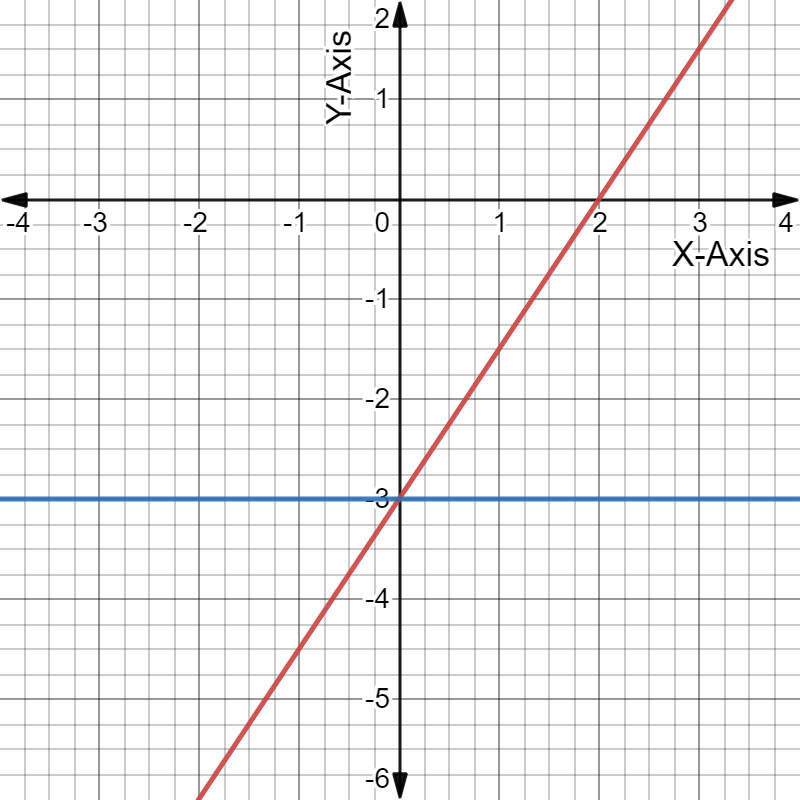
Page 136 Exercise 13 Answer
Given: y = 4x, y =−4x + 8

To Solve: The system of linear equations
Graph the first equation.
Graph the second equation on the same rectangular coordinate system.
Determine whether the lines intersect, are parallel, or are the same line.
Identify the solution to the system.
Graph of: y = 4x: y =−4x + 8

From the graph, it can be clearly seen that the point of intersection is (1,4) .
The solution of the system of linear equations y = 4x, y =−4x+8 is (x,y) = (1,4).
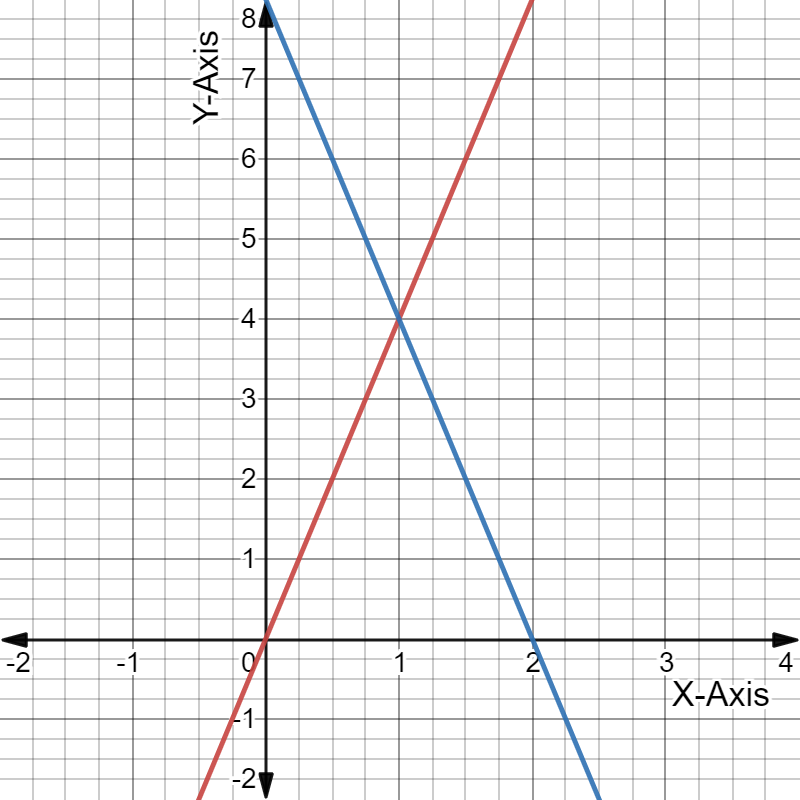
Big Ideas Math Algebra 1 Student Journal 1st Edition Chapter 5 Solving Systems Of Linear Equations Exercise 5.1 Page 136 Exercise 14 Answer
Given: y\(=\frac{1}{4} x+3\)
y\(=\frac{3}{4} x+5\)
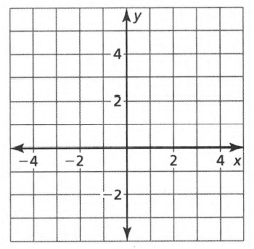
To Solve: The system of linear equations
Graph the first equation.
Graph the second equation on the same rectangular coordinate system.
Determine whether the lines intersect, are parallel, or are the same line.
Identify the solution to the system.
Graph of y\(=\frac{1}{4} x+3\):\(=\frac{3}{4} x+5\)

From the graph, it can be clearly seen that the point of intersection is (−4,2).
The solution of the system of linear equations y\(=\frac{1}{4} x+3\),\(=\frac{3}{4} x+5\)
is (x,y)=(-4,2)

Big Ideas Math Algebra 1 Exercise 5.1 Guide
Big Ideas Math Algebra 1 Student Journal 1st Edition Chapter 5 Solving Systems Of Linear Equations Exercise 5.1 Page 136 Exercise 15 Answer
Given: 3x−4y = 7, 5x + 2y = 3
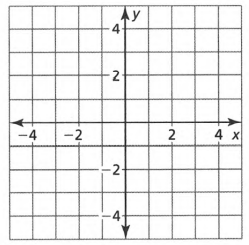
To Solve: The system of linear equations
Graph the first equation.
Graph the second equation on the same rectangular coordinate system.
Determine whether the lines intersect, are parallel, or are the same line.
Identify the solution to the system.
Graph of: 3x−4y = 7: 5x + 2y = 3

From the graph, it can be clearly seen that the point of intersection is (1,-1)
The solution of the system of linear equations 3x−4y = 7, 5x + 2y = 3 is (x,y) = (1,−1).
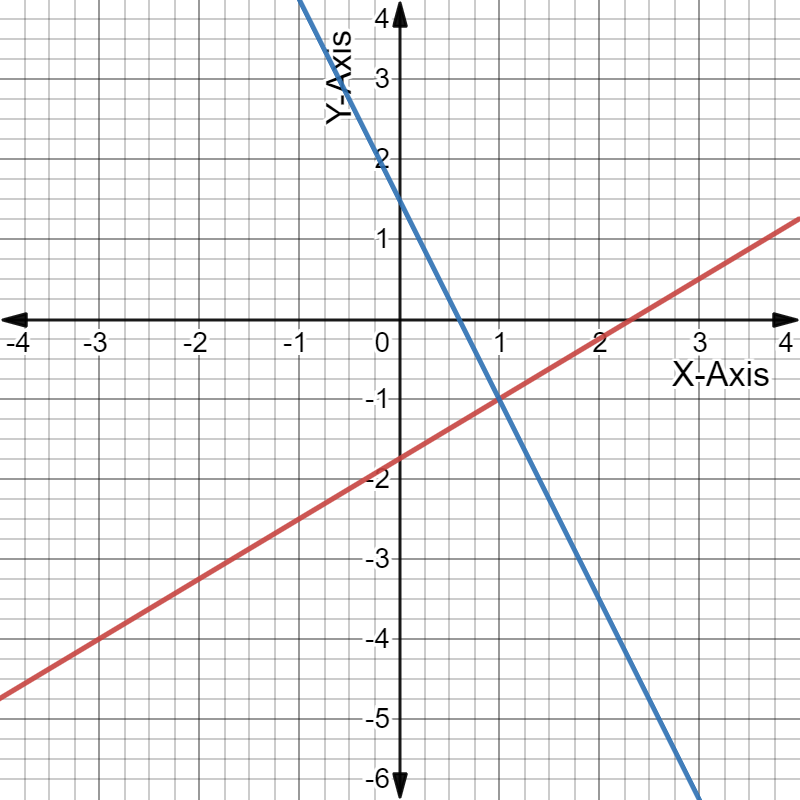
Page 136 Exercise 16 Answer
Given: A test has twenty questions worth 100 points. The test consists of x true-false questions worth 4 points each and y multiple-choice questions worth 8 points each.

To Find: Number of each type of question on the test
In this question, we will apply the method given in the “Tip” section and solve accordingly.
Use the substitution method to solve the system of linear equations.
A test has twenty questions worth 100 points. The test consists of x true-false questions worth 4 points each and y multiple-choice questions worth 8 points each.
Let x= number of TF questions (4 points each) and y= number of MC questions (8 points each)
“Test has twenty questions” means x+y=20.
“100 points” means 4x+8y=100.
Substitution Method:
Solve for a variable using x=20−y
Substitute for x in another equation :
4(20−y) + 8y = 100
⇒ 80−4y +8y = 100
⇒ 80 + 4y = 100
⇒ 4y = 20
⇒ y = 5
There are 5 multiple-choice questions.
Use any one of the two equations to find the value of x :
x + y = 20
⇒ x + 5 = 20
⇒ x = 15
There are 15 True-False questions.
A test has twenty questions worth 100 points. The test consists of x true-false questions worth 4 points each and y multiple-choice questions worth 8 points each.
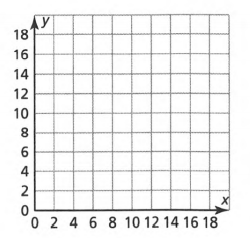
There are 5 multiple-choice and 15 True-False questions.
